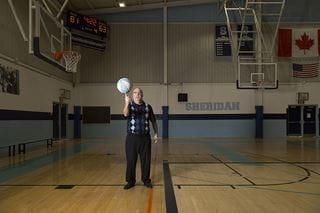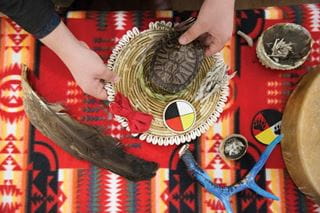
Learning to Stop and Breathe
 by Jill Scarrow – Jul 11, 2024
by Jill Scarrow – Jul 11, 2024 Meet Ace: they’ve had an anxiety attack and now find themselves lost in the mazes of Dreamworld, panicking as they search for the exit. Luckily, Ace soon meets up with Zen – a tiny, turquoise and purple dragon-like creature with an inviting smile who knows exactly what to do.
Zen guides Ace through Stop and Breathe, a video game designed to teach kids aged 11-14 how to tap into the power of their breath when anxious thoughts start to overwhelm them. In each level, players locate green circles where their character, Ace, must pause and begin a sequence of long, slow inhales and exhales that are initiated by the player, who is encouraged to follow along and breathe with Ace in real life. Only then can the player solve a puzzle to move on to the next level.
Stop and Breathe is the year-long capstone project created by One Must Imagine Games – a team of fourth-year Bachelor of Game Design students. Although it’s only been complete for a few months, the game has already caught the attention of industry. In June, it won Best Student Game at the Games for Change Festival in New York City; in August, the team will present their project at the Serious Play Conference in Toronto; and they were featured as part of the NexGen event during Toronto Games Week this spring.
It’s an impressive slate of accolades for the group, made up of Daws Peloquin, Humberto Benitez, Colin Billiau, Joel Bergen, Adam Pacheco, and JT Hampson. They were inspired to develop a game that addresses mental wellness by Kristina Arena, a professor from Sheridan’s Child and Youth program. She saw the potential to collaborate with game design’s talented students to create something that can have a real impact as children face long wait times to receive mental health care. In fact, the Centre for Addiction and Mental Health reports that, in 2020, 28,000 children were on wait lists for mental health care.
“Child and youth care deals with young people facing various challenges including emotional regulation, or difficulty with social and life skills,” explains Arena. “I thought: what if we could find a way to help many young people, using a technology they are familiar with, by creating a fun video game that could help them manage their mental health more effectively? Deep breathing is something they can do anywhere, at anytime.”
Pacheco says working across disciplines and tapping into Arena’s expertise was a great opportunity to practice incorporating external feedback into a project – a skill he knows the team will need now that they’ve graduated and are beginning their careers.
“The feedback that (Arena) was giving was immensely valuable. We treated her almost like a producer, in that sense. We wanted to make sure that we were upholding our end of the deal of what she expected to see in the game,” he says.
“I think we all also saw a lot of value in the concept too,” adds Bergen. “I think that, to some degree, we all had a way to connect with it. Being able to create something that was more than just a game really was a draw for our team as well.”
The team worked closely with Arena throughout the conceptualization and initial building phases of the game to make sure best practices on using breath to cope with anxiety were woven into the player’s experience.
“One of the hardest things we had to deal with was, how do we make the breathing engaging?” says Peloquin. “How do we make it feel like it's a necessary component to the game, rather than something we tacked on.”
“To some degree, we all had a way to connect with Stop and Breathe. Being able to create something that was more than just a game – that really was a draw for our team.” - Joel Bergen
Another challenge of building the game was representing feelings of anxiety in a way that was true to the emotion, but also still sensitive to the fact that some players might find a pretend situation would trigger upsetting feelings.
Arena says these steps of the process were an important part of making the game inviting for everyone, because many people will experience thoughts or feelings that intentional breathing practices can help relieve.
“I really give the group credit for not wanting to limit the game’s applicability solely to young people (who are) struggling with anxiety,” she says. “Learning how to breathe deeply is a valuable life skill, which can profoundly impact how people manage their emotions.“

And she’s delighted to see so much recognition coming for the game. While the team members themselves are relishing the wins coming their way, they’re also looking forward to having a chance to make connections in the game design world, especially as they’re just setting out into their careers.
“Being recognized at Games for Change was really great,” says Pacheco. “I think one of the big things was being present at that event and meeting the other people that are involved, getting to talk with them, was something that (was) immensely helpful, because one of the things that's relevant for a lot of industries is networking.”
Stop and Breathe is available on itch.io
Stop and Breathe team members celebrate their project. Back row, left to right: Colin Billiau, Daws Peloquin, Adam Pacheco, Joel Bergen. Front row, left to right: JT Hampson and Humberto Benitez along with Kat Kilgore, who created art for the project.
Media Contact
For media inquiries, contact Sheridan’s Communications and Public Relations team.



